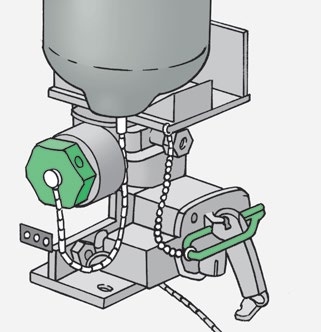Crewmen,
The automatic fire extinguishing system (AFES) is critical to the safety of your fellow Soldiers and your vehicle. But serious injuries, or worse, can happen if you mess around with the high-pressure AFES bottles.
Discharging an unsecured AFES bottle without an anti-recoil plug installed is extremely dangerous. The instant release of pressure causes the bottle to shoot like a projectile. You or a fellow crewman could be killed if you’re in the way!
But with an anti-recoil plug installed, the bottle contents are dispersed on both sides of the plug during an accidental discharge. That way the bottle won’t become a projectile.
To stay safe, it’s extremely important to install the anti-recoil plug on an AFES bottle before removing it from its mounting bracket. And keep the anti-recoil plug installed until the bottle is secured in the bracket again. Using the lock pin in the manual discharge handles will prevent manual activation but will NOT prevent electrical activation or discharging due to dropping the AFES bottle.
Here are some more AFES safety tips to keep in mind:
- Know the safety features of your vehicle’s AFES before attempting to handle the bottles. Bottle configuration and TM nomenclature can vary from system to system. For example, depending on the system, the anti-recoil plug might be referred to as an "expansion plug" or a "safety cap,” and the lock pin might be called a "safety pin.”
- Handle AFES bottles at all times as if they’re fully charged, no matter what the gauge reading says.
- Before removing an AFES bottle from its mounting bracket, insert the anti-recoil plug into the discharge port and the lock pin (if a lock pin is part of the bottle design) into the manual release handle. The anti-recoil plug and lock pin are attached to the bottle by short lanyards.
- Don’t remove the bottle from the bracket if the anti-recoil plug is not installed. Make sure the anti-recoil plug and lock pin remain installed while the AFES bottle is outside of its mounting bracket. If the anti-recoil plug can’t be installed, let your supervisor know.
 Bottle configuration varies...
Bottle configuration varies...
 ...from system to system
...from system to system
- Handle and store AFES bottles with extreme care. Dropping or otherwise impacting an AFES bottle can damage it, cause it to discharge or both.
- Do not discharge an AFES bottle that isn’t properly restrained.
There’s a four-part video that clearly illustrates what happens when you discharge an unrestrained AFES bottle with the anti-recoil plug installed versus without the plug. It’s definitely worth watching. You can see it here:
Another training video relates to one specific manufacturer's AFES, but the general safety concepts are common to all AFES. You can watch it here:
For more info, check out TACOM Safety of Use Message 21-004 at: